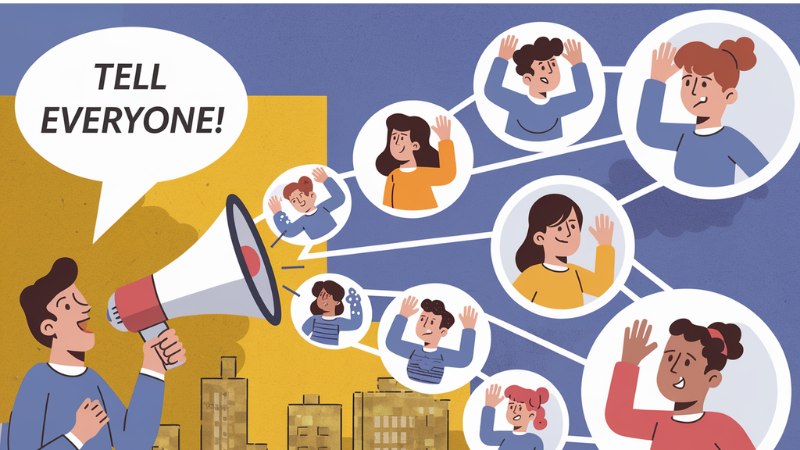Introduction
Referral marketing vs traditional marketing: This blog post will explore why referral marketing beats traditional marketing, and is superior for medium to long term growth. In today’s fast-paced digital landscape, businesses are constantly searching for the most effective ways to reach new customers and grow their brand.
Traditional marketing methods, such as print ads, TV commercials, and direct mail, have been reliable go-to options for decades. However, with the rise of digital technology and social media, referral marketing has emerged as a powerful alternative that often outperforms these traditional approaches.
Key Takeaways
- Trust Factor: Referral marketing works because 92% of consumers trust recommendations from people they know over traditional ads. Word-of-mouth marketing drives a significant portion of consumer sales, illustrating its effectiveness.
- Cost-Effectiveness: Referral marketing is much more cost-effective than traditional marketing, reducing customer acquisition costs by up to 70% while increasing customer lifetime value.
- Customer Retention and Loyalty: Customers acquired through referrals are 37% more likely to stay loyal and make repeat purchases, resulting in higher retention and loyalty rates.
- Viral Growth Potential: Referral marketing has the potential for viral growth, as seen with Dropbox’s rapid user expansion, which was largely driven by word-of-mouth recommendations.
- Personalization and Targeting: Referral marketing offers more personalised and targeted outreach compared to traditional ads, leading to higher conversion rates and customer satisfaction.
Table of Contents
- The Trust Factor: Why Referrals Work
- Cost-Effectiveness of Referral Marketing
- Customer Retention and Loyalty
- Viral Potential and Exponential Growth
- Personalized and Targeted Marketing
- FAQ’s
- Conclusion
1 The Trust Factor: Why Referrals Work
Trust is a crucial element in marketing. According to Nielsen, 92% of consumers trust referrals from people they know over any other form of advertising. This trust factor is a significant reason why referral marketing can outperform traditional marketing. When a friend or family member recommends a product or service, it carries more weight than an ad seen on TV or in a magazine.
Moreover, a study by the Word of Mouth Marketing Association (WOMMA) found that word-of-mouth marketing drives $6 trillion in annual global spending. This represents 13% of consumer sales, illustrating the immense power of personal recommendations.
2 Cost-Effectiveness of Referral Marketing
When comparing referral marketing vs traditional marketing one of the most compelling reasons to consider referral marketing over traditional marketing is cost-effectiveness. Traditional marketing campaigns can be expensive, often requiring substantial budgets for production and media placements. In contrast, referral marketing typically has lower upfront costs and focuses on leveraging existing customer relationships.
According to a report by Influitive, companies can reduce customer acquisition costs by up to 70% with referral marketing. This is because referred customers are more likely to convert and often come with lower acquisition costs than customers obtained through traditional marketing channels. Additionally, referred customers have a 16% higher lifetime value, meaning they are more likely to become loyal, repeat customers.

3 Customer Retention and Loyalty
Another significant advantage of referral marketing is its ability to foster customer retention and loyalty. Customers who come through referrals are not only more likely to make a purchase, but they are also more likely to stick around. Research by the Wharton School of Business found that referred customers have a 37% higher retention rate than customers acquired through other means.
This increased retention is due to the nature of referral marketing itself. When someone is referred by a friend or family member, they enter the customer relationship with a higher level of trust and a positive impression of the brand. This positive experience often translates into longer-term loyalty and higher customer lifetime value.
4 Viral Potential and Exponential Growth
Referral marketing can also provide a viral effect that traditional marketing often lacks. Well-designed referral programs encourage customers to share their positive experiences with others, creating a ripple effect that can lead to exponential growth. Unlike traditional marketing, which usually requires continuous investment to maintain momentum, referral marketing can grow organically as satisfied customers bring in new ones.
Dropbox is a classic example of a company that successfully leveraged referral marketing for viral growth. By offering additional storage space for both the referrer and the referred, Dropbox grew from 100,000 to 4 million users in just 15 months. This rapid growth was largely fueled by word-of-mouth recommendations and the power of referral marketing.

5 Personalised and Targeted Marketing
Finally, referral marketing offers a level of personalisation and targeting that traditional marketing struggles to achieve. In traditional marketing, ads are often broadcast to a broad audience, many of whom may not be interested in the product or service being advertised. On the other hand, referral marketing is inherently targeted because it involves customers recommending products to people they know will be interested.
This personalised approach can lead to higher conversion rates and better customer satisfaction. A survey by the Harris Poll found that 82% of Americans seek recommendations from friends and family before making a purchase. This demonstrates the importance of personalization and targeted marketing, which referral marketing naturally provides.
FAQ’s
1. Why is referral marketing more effective than traditional marketing?
Answer: Referral marketing is more effective because it leverages trust. Studies show that 92% of consumers trust recommendations from people they know over traditional advertisements. This trust factor significantly boosts conversion rates, making referral marketing more impactful than traditional methods like TV ads or print media.
2. How does referral marketing help reduce customer acquisition costs?
Answer: Referral marketing is cost-effective because it capitalizes on existing customer relationships. It eliminates the need for large advertising budgets while bringing in highly qualified leads. In fact, businesses can reduce customer acquisition costs by up to 70% through referrals, as referred customers are more likely to convert and have higher lifetime value.
3. Can referral marketing lead to exponential growth?
Answer: Yes, referral marketing has the potential for viral growth. Satisfied customers are more likely to share their positive experiences with others, creating a ripple effect that can lead to exponential growth. For example, Dropbox grew from 100,000 to 4 million users in just 15 months, largely due to a successful referral program.
Final Thoughts
In the debate between referral marketing vs traditional marketing referral marketing clearly offers several advantages over traditional marketing methods, including higher trust levels, cost-effectiveness, better customer retention, viral potential, and targeted reach. As more businesses recognize these benefits, referral marketing is becoming a vital component of their overall marketing strategy.
By understanding and leveraging the power of referrals, companies can not only attract new customers but also build a loyal customer base that continues to grow organically. With the right approach and a well-designed referral program, businesses can harness the full potential of referral marketing and outperform traditional marketing efforts.
Speak soon
Len
- Standard Operating Procedures: Your Ultimate Guide to Streamlining Business Efficiency - September 5, 2025
- Brutal Truth: Your Customer Perception Is Sabotaging Your Success (Here’s The Proof) - July 25, 2025
- The Counter-Intuitive Customer-Centric Culture Strategy That Changes Everything - July 11, 2025
